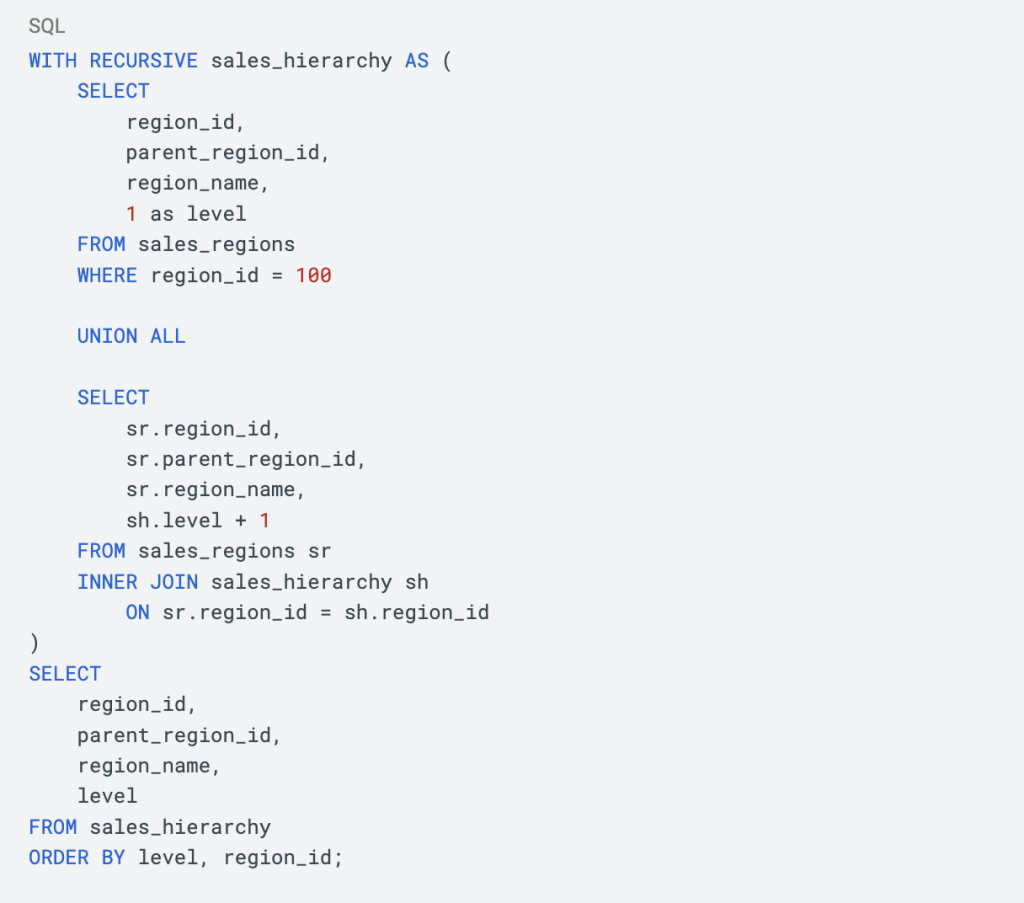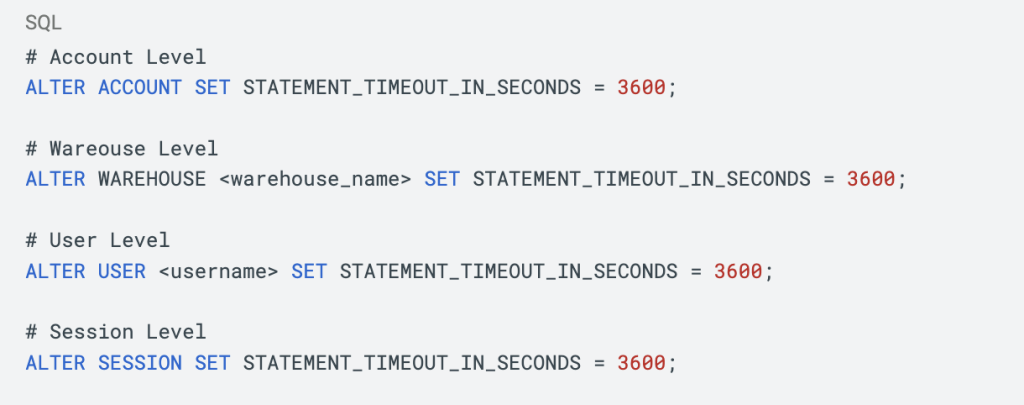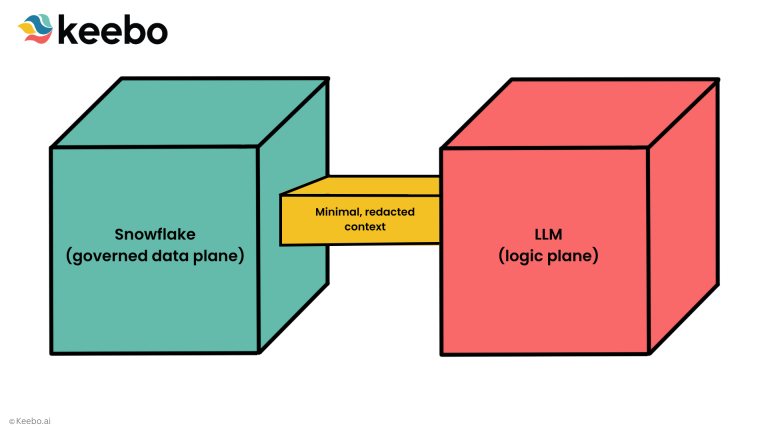How Snowflake Query Timeout Keeps Costs from Snowballing Out of Control
Take a look at this SQL query. See if you can spot the problem.

If your answer is the ON sr.region_id = sh.region_id line, you’re correct. This query includes a fundamental logic error within that INNER JOIN condition. Executing this query in Snowflake would create a self-referencing loop, an endless cycle as each iteration keeps finding the same region_id over and over again, burning through credits each time. That is, until Snowflake query timeout—the platform’s built-in mechanism to automatically stop long-running queries—steps in.
Snowflake may execute a query timeout due to poor query logic, or to:
- Ensure fair resource allocation within shared environments
- Risk of a query returning stale or inconsistent data if it hangs too long
- Removing queuing bottlenecks due to one runaway query
Snowflake query timeouts provide a safety net for situations that would otherwise eat into your credit consumption. As such, it’s a key component of any effort to optimize Snowflake cost and performance.
What is Snowflake query timeout?
Snowflake query timeout is a built-in mechanism to set the maximum duration of a query before the system automatically terminates it. Snowflake’s default query timeout is set at 24 hours (86,400 seconds). This keeps long-running queries from consuming too many resources and preventing other queries from executing.
How to configure Snowflake query timeout
Even with the default settings kicked in, 24 hours is a long time. Thankfully, Snowflake enables you to configure query timeout settings for each session, user, warehouse, or account. Note that Snowflake considers these settings in reverse precedence, with the account level having the lowest precedence and the session level overriding all others.
You can make these adjustments with a simple SQL command. Let’s consider all four levels, setting the timeout at 1 hour (3600) each.

It’s important to be judicious in configuring Snowflake query timeouts. Although your instinct may be to set them lower and, theoretically, maximize your savings, this approach comes with some risks:
- Premature termination for efficient but long-running queries (i.e. high data volumes or use of small warehouses), resulting in incomplete results, failed jobs, and user frustration
- User and application disruption as critical business processes, dashboards, or data pipelines fail unpredictably
- Additional costs, operational overhead, and warehouse loads as users re-execute timed out queries
- Difficulty troubleshooting performance issues due to frequent, unexplained query cancellations
Whatever your query timeout limit, remember that it’s an arbitrary number. There will be necessary queries that run longer than your median, and setting query timeout too low will unnecessarily prevent those queries from executing.
What do you do if Snowflake times out your query?
So what happens if Snowflake times out a query? Does this automatically mean there’s a problem with the query? Not necessarily.
Sometimes, queries time out due to issues like the ones mentioned above. Other times, it’s because a query has a longer execution time, but not because of any problem with the query itseslf—it may be looking at a large volume of data, for example. Frequent query timeouts can also be an indicator that you’ve set your timeout limit too low (see above).
When Snowflake times out a query, it’s important to look at why that timeout happened and how to fix it going forward. Here are some steps you can take to troubleshoot a Snowflake query timeout:
- Review the error message and confirm it’s a query timeout, not a network or connection timeout.
- Go to Monitoring > Query History in Snowsight to review the query’s metrics, including how long it ran and where it potentially stalled.
- Optimize the query design to improve performance (you can use a tool like Keebo Workload Intelligence for AI-generated insights and recommendations to improve).
- If the query is unable to be optimized (for example, it’s an auto-generated query), consider using query routing to send it to a warehouse with more provisioned resources
- Re-run the optimized query and monitor its performance again.
If the issue isn’t with the query itself, you can troubleshoot some additional areas:
- Insufficient compute resources due to small warehouse sizes or high concurrency
- Disk spillage, which results in queries running longer than in-memory processing
- Row explosion due to poorly constructed joins
- Poor data pruning, requiring Snowflake to scan more data than necessary
- Network or external factors—although Snowflake works to minimize latency impacts, these issues can occasionally contribute to delays
- User settings, such as a client, BI tool, or driver (ODBC/JDBC) with timeout settings that are more restrictive than Snowflake’s settings
The impact of Snowflake query timeout on cost and performance
Snowflake query timeout can be a helpful feature for keeping cost and performance under control. In terms of costs, it can provide a safety net to prevent long-running queries from driving up costs. In terms of performance, it helps ensure no one query monopolizes warehouse resources, thus preserving performance for other workloads and maintaining system stability.
However, like many of the features provided in Snowflake for mitigating cost and performance overreach, this tool does come with some risks:
- Terminating necessary but long-running queries rather than provisioning more resources to accelerate them (either by rightsizing warehouses or routing queries)
- Require re-tries on timed out queries, thus charging double or triple for the same actions
- Snowflake still bills for every second of execution prior to timeout—a reactive vs. proactive savings solution
To handle dynamic workload, you need a dynamic optimization tool. Keebo is an AI agent for cost and performance that helps you save 30% without sacrificing speed and performance. Our pay-as-you-save model ensures consistent efficiency and ROI.
Schedule a demo today to get started.


